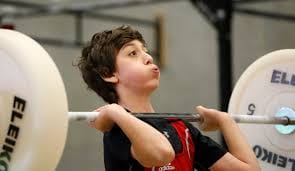
An incredibly controversial idea in the strength and conditioning community is the idea of children or young teens lifting weights. Conditioning for sport is a massive industry and also a massive part of improving performance amongst athletes of all ages. If conditioning is so important, why would any coach stray away from strength training young athletes to give them the experience in this setting as early as possible? Surprisingly, the injury frequency on young athletes in sports such as powerlifting or weightlifting are actually surprisingly lower than that of football or rugby. (Faigenbaum AD et. al 2010:548) It could be argued that as soon as a child can display “adequate balance and proprioception” (Dahab and McCambridge, 2009:224) they could potentially be involved in a weightlifting or strength program.
The argument against a strength or resistance program for youths are the growth palate injuries that could potentially ‘stunt’ the growth of a young person. A growth palate injury in children is most likely actually to be caused by injuries sustained in games like rugby or American football- as the impacts can cause fractures. It is highly unlikely that a child will suffer a growth plate injury when weight training, if proper technique and instruction are used, with good supervision.
A 1986 article in the British Journal of Sports Medicine by Jenkins and Mintowt-Czyz (1986) has reported serious growth plate injury in the wrist of a 13-year-old boy. This injury was sustained in an uncontrolled environment, as the young boy performed a maximal lift while his parents were away in their garage/gym. This is one of the only academically recorded instances of negative effects of weight training- and was partly due to the uncontrolled environment the boy was in.
In 2007, a 9-week strength program was followed by a group of pre-teen males and females. This was made up of various ‘traditional’ lifts such as the deadlift or barbell squat. Without any report of injury, massive gains in strength were made. This study was by Faigenbaum and McFarland (2007).
Many papers and research groups have found that “there is actually an increasing amount of evidence suggesting that RT has the potential to increase bone mineral density.” (Behm et al., 2008:548) This completely diminishes any argument about the potential damage to epiphyseal lines in children’s long bones. Furthermore, it contradicts many myths misconstrued by the media and population of average ‘gym-goers’.
In conclusion, weight training, weightlifting and resistance training can be nothing but positive for young people, as they pick up and develop the skills to further their sporting career. Also, increasing bone mineral density could help to produce healthier children, and lastly, we could battle obesity worldwide by implementing more weightlifting classes.
Overall, evidence suggests young people SHOULD lift weights.
REFERENCES
- Behm, D.G., Faigenbaum, A.D., Falk, B. and Klentrou, B. (2008) Canadian Society for Exercise Physiology position paper: resistance training in children and adolescents. Appl. Physiol. Nutr. Metab. Vol. 33, No. 1: 547-567.
- Dahab, K.S. and McCambridge, T.M. (2009) Strength Training in Children and Adolescents: Raising the Bar for Young Athletes?Sports Health. Vol. 1, No. 3: 223-226.
- Faigenbaum AD, & Myer GD. (2010) Resistance training among young athletes: safety, efficacy and injury prevention effects. Br J Sports Med. 44(1):56-63.
- Faigenbaum A, McFarland J, Johnson L, Kang J Et al. Preliminary evaluation of an after-school resistance training program. Precept Mot Skills. 2007. 104:407-415
- Jenkins, N.H. and Mintowt-Czyz, W.J. (1986) BILATERAL FRACTURE-SEPARATIONS OF THE DISTAL RADIAL EPIPHYSES DURING WEIGHT-LIFTING. British Journal of Sports Medicine. Vol. 20, No. 2: 72-73.
FURTHER READING; PEER REVIEWED
https://squatuniversity.com/2016/03/04/when-can-my-child-start-lifting-weights/
https://musqle.com/does-lifting-weights-affect-the-growth-in-teenagers